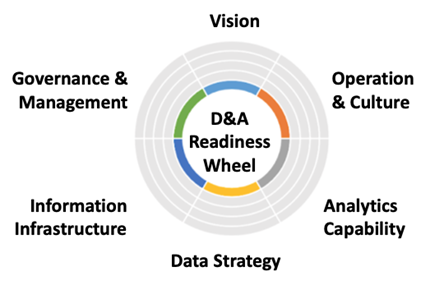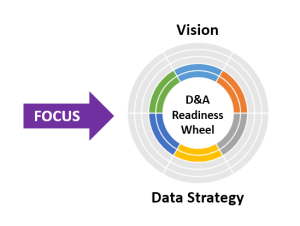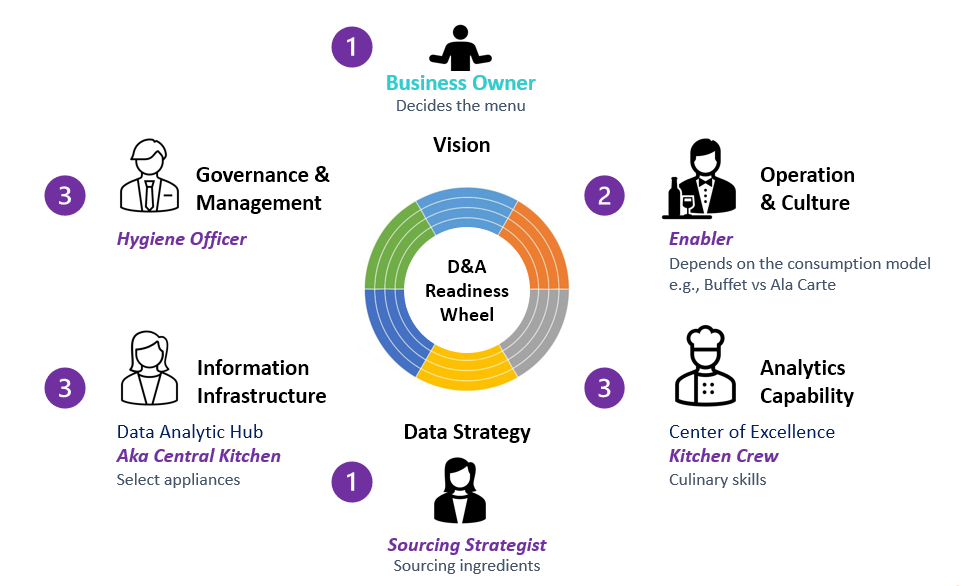For many businesses, scaling and expansion tend to be pipedreams rather than goals within reach. Uninformed and unstandardised processes that lead to bottlenecked pipelines are just some of the common data-based problems that keep businesses stagnant.
Often, data volume isn’t what separates businesses that succeed from those that don’t. After all, most businesses today have digital tools at their disposal to monitor everything from customer behaviour to sales. Rather, the ability to make sense of data often proves to be the key in overcoming growth plateaus.
Advancing step-by-step with the data readiness wheel
The Readiness Health Check-up Wheel provides business leaders with an intuitive framework for quantifying their progression in data management and strategy. From IT business analysts to senior management, this article will provide a step-by-step guide for executives across all industries so that they can help assess their companies’ state of data readiness and identify the next, most effective steps that are needed for achieving truly data-based digital transformation.

Readiness Health Check-up Wheel status of organisations before data management strategies have been implemented.
The Wheel breaks down data readiness into six core elements listed below, in clockwise direction:
- Vision: How and why a company seeks to use big data. Knowing why data monitoring is important to your business success in the first place is paramount for agility and continuous transformation.
- Operation & Culture: How data is treated within the company. The responsibility of proper data handling does not fall solely onto the IT department, but across the entire organisation. Being fluent in analytics and business intelligence platforms is what enables continuous adaptation and data improvement.
- Analytics Capability: The company’s overall data analytics skill level. Includes dashboard building and automated tuning capabilities across data science and machine learning platforms to streamline business processes.
- Data Strategy: Identifying the right data to gather so that intelligence strategies can fully support the existing business transformation strategy. Data must be harmonised rather than exist in silos to ensure effective security measures and event management.
- Information Infrastructure: Architecture robustness for data processing, algorithm computation, and information transport. Data should be processed in proper architecture and cloud database management systems.
- Governance & Management: Whether data quality and conflict is handled appropriately. This is made possible through the integration of data management principles into management solutions such that information remains transparent and auditable.
Common data management issues and blind spots
Hiring skilled data analysts is not the silver bullet to becoming data-ready. Rather, every single employee along the company value chain needs to be data trustees who can be relied upon to collect the right kind of data (Data Strategy), handle data appropriately (Governance & Management), and use intelligence platforms fluently (Operation & Culture).
That said, recruiting employees who possess such capabilities and equipping existing team players with comprehensive data skillsets is no mean feat. Small & Medium enterprises (SMEs) with less than $100 million in operating revenue or workforces of less than 200 often have limited resources to plug skill gaps or execute data strategies effectively.

Filling up the Readiness Health Check-up Wheel.
With few resources at their disposal, SMEs often spend more time and effort detangling day-to-day processes such as invoicing. As a result, the overarching data strategy is often overlooked, even with the help of programmes such as the Productivity Solutions Grant and the SMEs Go Digital Grant.
Even companies with a proper Operation & Technology Roadmap (OTR) tend to miss out on including data in their operational strategy. Emphasis is often placed upon technology inclusion for products and services instead, leading to blind spots and inefficiencies that are left unaddressed. Unfortunately, such problems are not just limited to SMEs, but can also be spotted within nonprofits, ministries, statutory boards, as well as government and government-aided schools.
Building a data-fluent team
To ensure holistic coverage within an organisation’s data strategy, every employee and department needs to be fully aware of how their role contributes to the wider data pipeline.

Imagining how various organisational roles operate in a kitchen can help illustrate data-ready teams in action:
- Business Owner (Vision): Determines the menu. As the individual at the helm of operations, the business owner chooses the types of products and services to offer customers depending on market viability and resource availability.
- Enabler (Operation & Culture): Waiters or butlers provide recommendations to customers based on their preferences, consumption habits, risk appetites, and more.
- Kitchen Crew (Analytics Capability): This is where data is refined and chopped up into bite sized pieces that the rest of the team can stomach and process effectively for smooth business execution.
- Sourcing Strategist (Data Strategy): To gather the right data, strategists must understand how data comes together in the same way food scientists understand how food ingredients interact with each other to create a gastronomic experience.
- Central Kitchen (Information Infrastructure): It’s not enough to have the right ingredients. Specialised equipment is often required to process and cook food in specific ways. Similarly, selecting the right tools is vital to processing data correctly.
- Hygiene Officer (Governance & Management): Standards must be maintained no matter how busy the kitchen becomes. Governance & management officers ensure that best practices are always abided by.
Start writing here...